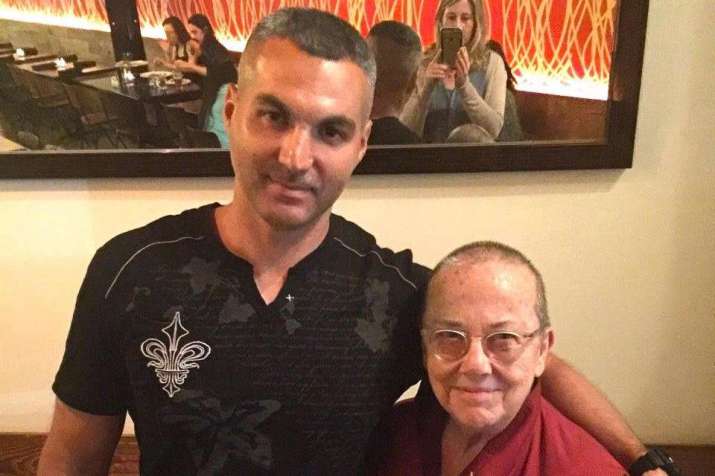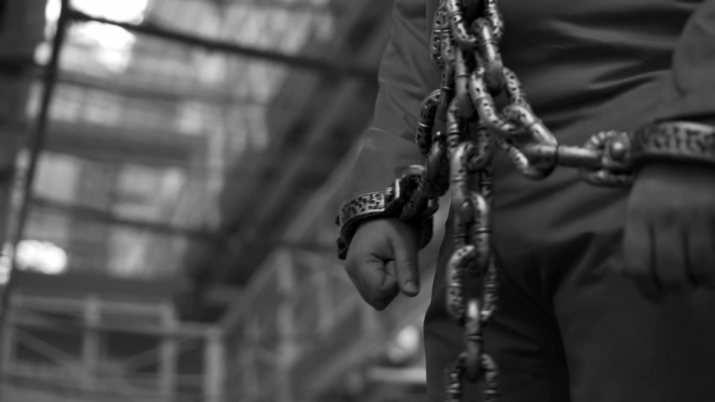FEATURES|THEMES|Commentary
Real Practice Begins When We Change Our Mind
 Ven. Robina Courtin, right, with A. J. Esquer in Los Angeles soon after his release from prison, June 2017. Photo by Kate Macdonald
Ven. Robina Courtin, right, with A. J. Esquer in Los Angeles soon after his release from prison, June 2017. Photo by Kate MacdonaldThere’s a saying in Buddhism that if we can change something, please change it! But the question is: what if we can’t? This is when Buddhist practice really begins. And the people whose practice I admire most are those in prison. They can’t change their situation, so they have no choice but to change their mind.
In early 1996, when I was editor of the FPMT* magazine Mandala in Santa Cruz, California, I received a letter from a young Mexican-American, Arturo, who was in a high-security prison. He told me that he’d read a book by Lama Thubten Yeshe and that he was “moved by the teachings on compassion” and wanted to know more about Buddhism. What became the Liberation Prison Project developed from there.
Within a year I had 40 prisoners writing to me. I’d answer their letters and always send books. I started visiting prisons: giving classes, leading meditations. It was very moving for me. I could see that these prisoners, these human beings, were just like the rest of us but living in pretty dire circumstances.
I read the memoir of a woman in Florida who, with her husband, was wrongly accused of murdering two policemen and spent 17 years in prison—12 of them on death row—in what we can only imagine is a nightmarish scenario; her husband was even executed. She said that finally she realized that she couldn’t change anything, “but they couldn’t take my mind from me. So I decided: I am not a prisoner, I am a monk; I am not in a cell, I’m a cave.”
The irony for most of us is that even though we are not in prison we often get overwhelmed by our circumstances, become victims of them, blaming them, and truly believe we can’t change.
Writing in reply to a letter from Arturo, Lama Zopa Rinpoche told him, “Your prison is nothing in comparison with the inner prison of ordinary people”—and that’s us! “The prison of attachment, the prison of anger, the prison of depression . . .” My friends in prison know this to be true.
For me the experience of working with these human beings was inspirational. “Practice” takes on an entirely new level of reality. One of the first men I met in person, a friend of Arturo’s and a former gangster, Richie, told me in his letters during our first year of correspondence how he was very laid back, “But when I get angry I get really angry.” He had killed three men on the streets; this is common among the gangs. There he was behind glass in the top-security prison, covered in tattoos—it’s all prison art, they proudly tell me!—speaking to me via a telephone. “How’s your anger, Richie?” I asked, smiling. He blushed beneath his tattoos and confessed that he’d had a fight with his cellmate that morning and “put his head down the toilet. But,” he said, “I took it out again!”
That’s practice! I thought. It’s relative, isn’t it? He didn’t kill a fourth person.
A Puerto Rican friend, Timothy, told me in his first letter that he’d heard people could get spiritual powers from meditation. He was very excited! “Then I could harm my enemies,” he said. “But I experienced joy instead! And,” he added, “there was this green light in my cell. I didn’t know whether it was internal or external, but I knew it was feminine.” Later he read Buddhist books and “discovered her name was Tara.”
 From videoblocks.com
From videoblocks.comSo many of them talk about how they help those worse off than themselves. My friend on death row in Kentucky, Mitchell, is a dear friend and mentor to many of the other 40 men he lives with. One of them, he told me, “thinks of torture all the time.” Mitchell is his dearest friend; he understands him, takes care of him, protects him. Richie, the former gangster, wrote about looking after his old Alzheimers-suffering cellmate: chopping up his food so his toothless friend can eat it, cutting his toenails for him, cleaning up his shit.
Arturo is finally out of prison. He was 18 when I met him, fresh from leaving the gangs—a courageous decision in prison, I can tell you—which he joined when he was 11. He has been imprisoned since he was 12. He has spent the past 20-plus years getting a high school education, studying languages, and practicing a spiritual path. Now he’s 40, going grey, and still amazed to be among the lucky few of the California prisoners able to find a kind lawyer to work pro bono for them to navigate his release. I am so happy for him.
And Mitchell on death row? “I’m ready for that electric jolt!” he told me. He has asked me to be with him when he dies. I will be honored to do so.
* Foundation for the Preservation of the Mahayana Tradition
See more
Liberation Prison Project
RobinaCourtin.com
Related news from Buddhistdoor Global
Kenya Prison Uses Mindfulness to Reduce Violence and Bridge Gap Between Guards and Inmates
Buddhism the Fastest-growing Religion in Scottish and English Prisons
California Court Affirms Death Sentence for Jarvis Jay Masters
Buddhist Transitional Community in Pennsylvania Offers Refuge for Former Convicts
Related features from Buddhistdoor Global
Reaching Out to the Incarcerated as a Buddhist Practice: A Tale of Compassion in Arkansas
Venerable Tsunma Lobsang Rinchen Khandro: Acting with Compassion for All Those Suffering from Adversity
“We Have All Made Mistakes” - Teaching Mindfulness in Prisons: A Different Kind of Rehabilitation














